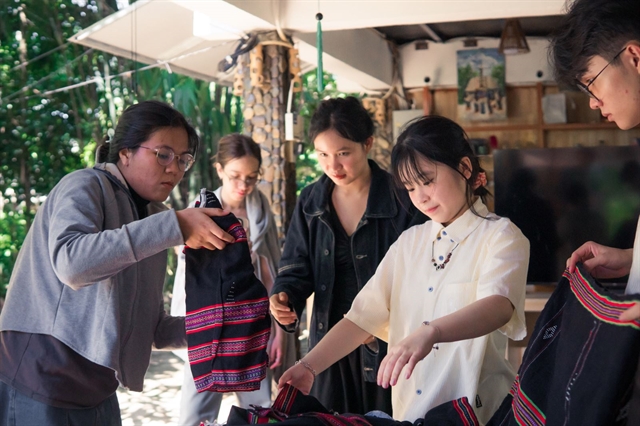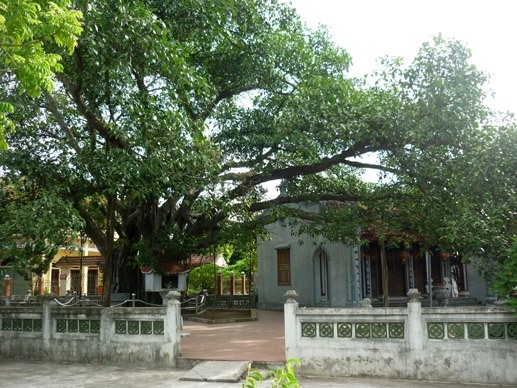 Features
Features

The Red River Delta province of Hưng Yên held a ceremony last Saturday to commemorate some 1,145 resistance soldiers and people killed by the French and their henchmen during their re-colonisation of Viet Nam
 |
| Colonel Hoang Dang Vinh at the ceremony. Photo www.qdnd.vn |
HƯNG YÊN – Strong emotions welled up in Colonel Hoàng Đăng Vinh as he stood under a 200-year-old banyan tree.
This was no ordinary tree.
Standing in La Tiến Hamlet, Hưng Yên Province, the tree helped Vinh recall the plight of his brethren 70 years ago as they suffered the brutality of French occupation.
Between 1949 and 1954, the tree had witnessed some 1,145 resistance soldiers and people, including 121 local villagers, being tortured and executed by the French and their henchmen at their detention camp in Nguyên Hòa Commune, Phù Cừ District.
To reinforce their reoccupation of Viet Nam from 1946, the French had set up a camp in the commune in 1949 to stamp out the Vietnamese people’s resistance in the region.
Vinh’s elder brother was among those who were captured and killed by the French near the tree. Vinh was also arrested and tortured by the enemy in La Tiến. However, he managed to escape from the prison.
Vinh later became one of the soldiers who captured French General De Castries during the famous Điện Biên Phủ Campaign in 1954, which played a crucial role in ending French rule.
“I was honoured as President Hồ Chí Minh awarded me his badge when I was only 19 years old. I consider it the biggest achievement in my life. It is the motivation for me to continue to live a life worthy of our nation and people,” Vinh said at a ceremony held last Saturday to commemorate the local army and people’s spirit during the resistance against French colonialism.
 |
| The 200 year old banyan tree in La Tien Hamlet. Photo hungyentourism.vn |
The La Tiến Banyan Tree and temple were recognised as national revolutionary relic sites last year.
Last Saturday’s ceremony was organised by Hưng Yên authorities, in collaboration with Quân Đội Nhân Dân (People’s Army) newspaper, Đại Đoàn Kết (Great Unity) newspaper, and Việt Nam Television.
The event highlighted the sacrifice of female guerrilla leader Trần Thị Khang, then secretary of the Phù Cừ District Women’s Union for National Salvation, and leader of the Hoàng Ngân Female Guerrilla Squad.
On June 8, 1950, Khang was caught by French troops. They tortured her for five days until she died, but failed to get any information from her. Her body was thrown into the Luộc River. She was just 21 then.
The French colonialists tortured and massacred soldiers and citizens, but they could not destroy the people’s patriotism and desire for independence.
Nguyễn Thị Doan, former Vice President of Việt Nam, who was attending the event, said that her father was also killed by the French at La Tiến and his body thrown into the Luộc River.
“My father’s and other soldiers’ deaths demonstrate the faith of the Vietnamese army and people in the cause of national independence,” she said.
“Thinking about him, I am determined to continue to strive and overcome difficulties to fulfill my duty,” she said.
In January 1954, Vietnamese resistance fighters along with local guerrillas overran the French post in La Tiến Village, and liberated the whole province.
The tree also witnessed the blossoming of love between revolutionary soldiers and local women. One such couple is veteran Nguyễn Đức Khoát and his wife Trần Thị Khuyến.
When the French were stationed in La Tiến, Khoát was among the locals gathering intelligence for the resistance, while Khuyến was forced by the enemy to build their fortifications. They joined a campaign against the colonialists and fell in love. In August 1955, they got married in the newly-liberated province of Hưng Yên.
“Every inch of La Tiến is permeated by the sacrifice of fighters and local people. In order to uphold this tradition, Hưng Yên’s leadership and people will do their best to further develop the province,” said Đỗ Tiến Sỹ, the province’s Party Committee Secretary.
The provincial Party, authorities and people would stay united, develop the economy, ensure social security and improve local residents’ living standards, he said.
The province has seen major advancements in industrialisation, urbanisation and building new style rural areas.
In the last 20 years its public budget has increased 100-fold, reaching nearly VNĐ9 trillion (US$400 million). It is expected to be among the provinces earning enough to cover their own needs next year. – VNS




